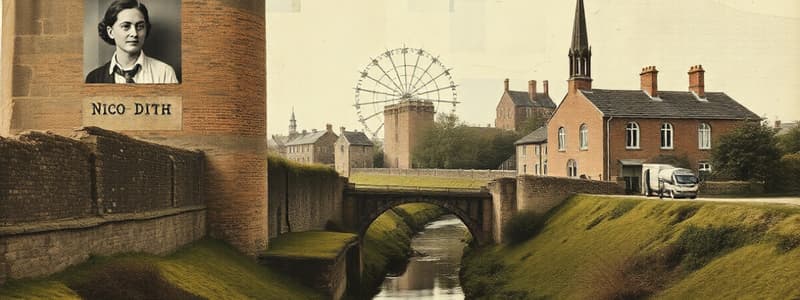Podcast
Questions and Answers
How long is the Nico Ditch?
How long is the Nico Ditch?
- 12 miles
- 6 miles (correct)
- 3 miles
- 9 miles
Between which centuries was the Nico Ditch likely constructed?
Between which centuries was the Nico Ditch likely constructed?
- 5th and 11th (correct)
- 16th and 18th
- 12th and 15th
- 1st and 4th
In which English county is the Nico Ditch located?
In which English county is the Nico Ditch located?
- Yorkshire
- Greater Manchester (correct)
- Cheshire
- Lancashire
What is a possible purpose of the Nico Ditch?
What is a possible purpose of the Nico Ditch?
What is the earliest documented name for Nico Ditch?
What is the earliest documented name for Nico Ditch?
What does the Anglo-Saxon word 'micel' mean?
What does the Anglo-Saxon word 'micel' mean?
Which golf course contains a well-preserved section of the Nico Ditch?
Which golf course contains a well-preserved section of the Nico Ditch?
What is the potential origin of the name 'Nico'?
What is the potential origin of the name 'Nico'?
What is the approximate width of the Nico Ditch in the sections that remain?
What is the approximate width of the Nico Ditch in the sections that remain?
Which park contains a visible section of the Nico Ditch?
Which park contains a visible section of the Nico Ditch?
Which bodies of water now cover parts of the Nico Ditch?
Which bodies of water now cover parts of the Nico Ditch?
Historians believe that the names of Gorton and Reddish came from a legendary battle related to Nico Ditch. Is this true or false?
Historians believe that the names of Gorton and Reddish came from a legendary battle related to Nico Ditch. Is this true or false?
According to legend, who built Nico Ditch in a single night?
According to legend, who built Nico Ditch in a single night?
What is the shape of the Nico Ditch's profile, as determined by archaeological investigations?
What is the shape of the Nico Ditch's profile, as determined by archaeological investigations?
The Nico Ditch may have served as a boundary between which two Anglo-Saxon kingdoms?
The Nico Ditch may have served as a boundary between which two Anglo-Saxon kingdoms?
What is the depth of the Nico Ditch, in sections which still exist?
What is the depth of the Nico Ditch, in sections which still exist?
Which of these is a modern use of the Nico Ditch course?
Which of these is a modern use of the Nico Ditch course?
What is the Latin term for 'large ditch' used in reference to the Nico Ditch?
What is the Latin term for 'large ditch' used in reference to the Nico Ditch?
Which of these locations is least likely to be on the course of the Nico Ditch?
Which of these locations is least likely to be on the course of the Nico Ditch?
What status does a 150-yard segment of the ditch in Platt Fields have?
What status does a 150-yard segment of the ditch in Platt Fields have?
Flashcards
What is the Nico Ditch?
What is the Nico Ditch?
A 6-mile long earthwork in Greater Manchester, England, possibly a defensive fortification or boundary marker dating from the 5th-11th century.
Mykelldiche
Mykelldiche
The ditch is referenced as "Mykelldiche", meaning "large ditch" in old documents.
Origin of "Nico"
Origin of "Nico"
A possible origin is the Anglo-Saxon word Hnickar, a water spirit.
Nico Ditch Location
Nico Ditch Location
Signup and view all the flashcards
Nico Ditch Timeframe
Nico Ditch Timeframe
Signup and view all the flashcards
Purpose of Nico Ditch
Purpose of Nico Ditch
Signup and view all the flashcards
Legend of Nico Ditch
Legend of Nico Ditch
Signup and view all the flashcards
Archaeological Findings
Archaeological Findings
Signup and view all the flashcards
Preserved Section
Preserved Section
Signup and view all the flashcards
Protected Segment
Protected Segment
Signup and view all the flashcards
Study Notes
- Nico Ditch is a 6 mi (9.7 km) long earthwork in Greater Manchester, England, stretching from Ashton-under-Lyne to Stretford.
- It was built between the 5th and 11th centuries.
- Nico Ditch may have served as a defensive fortification or a boundary marker.
- Surviving sections are 4–5 yards (3.7–4.6 m) wide and up to 5 feet (1.5 m) deep.
- A portion of the earthwork is a protected Scheduled Ancient Monument.
Etymology
- The earliest reference is in a charter (1190-1212) granting land in Audenshaw to Kersal Cell monks, calling it "Mykelldiche" and magnum fossatum ("large ditch" in Latin).
- The name Nico (or Nikker) became common in the 19th-20th century.
- Nico could be a corruption of Mykelldiche.
- The Anglo-Saxon word micel means "big" or "great".
- Another possible origin for "Nico" is the Anglo-Saxon word nǽcan, meaning "kill".
Course
- Nico Ditch runs from Ashton Moss (Ashton-under-Lyne) to Hough Moss (east of Stretford).
- It passes through Denton, Reddish, Gorton, Levenshulme, Burnage, Rusholme, Platt Fields Park, Withington, and Chorlton-cum-Hardy.
- The ditch crosses four present-day Greater Manchester metropolitan boroughs.
- It aligns with parts of the borders between Stockport and Manchester, and Tameside and Manchester.
- A section is now under the Audenshaw Reservoirs.
- The ditch may have originally extended west to Urmston.
History
- Nico Ditch was built between the end of Roman rule in Britain (early 5th century) and the Norman Conquest (1066).
- Its original purpose is uncertain, but possibilities include defense or administrative boundary.
- It may have marked a 7th-century boundary for Anglo-Saxon expansion, or a late 8th/early 9th century boundary between Mercia and Northumbria.
- During the early medieval period, Northumbria, Mercia, and Wessex fought for control of North West England along with the Britons and Danes.
- Since the Middle Ages, the ditch has been used as a boundary.
- Legend says the inhabitants of Manchester built it in a single night as protection against Viking invaders in 869–870.
- Supposedly, each man had to dig a section and build a bank equal to his height.
- 19th-century folklore claimed a battle between Saxons and Danes occurred at the ditch, giving Gorton ("Gore Town") and Reddish ("Red-Ditch") their names.
- Historians dismiss this idea, as the names actually derive from "dirty farmstead" and "reedy ditch."
- Antiquarians and historians have studied the ditch since the 19th century.
- From 1990-1997, the University of Manchester Archaeological Unit excavated sections in Denton, Reddish, Levenshulme, and Platt Fields.
- These excavations aimed to determine its age and purpose.
- No construction date was established.
- Investigations revealed that the bank north of the ditch dates to the 20th century.
- The ditch's U-shape (rather than a V-shape) suggests it was a territorial boundary marker.
- The project concluded it was most likely a boundary marker.
Preservation
- Despite weathering, the ditch is still visible in short sections (up to 4–5 yards wide and 5 feet deep).
- The 330-yard stretch through Denton Golf Course and the section in Platt Fields Park are the best-preserved remains.
- A 150-yard segment in Platt Fields was protected as a Scheduled Ancient Monument in 1997.
- The rest of the ditch is unprotected.
Studying That Suits You
Use AI to generate personalized quizzes and flashcards to suit your learning preferences.




